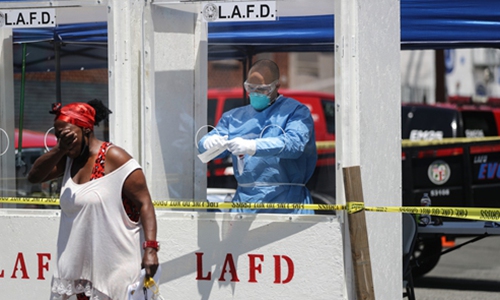Coronavirus exposes new gaps in US inequality
By Liu Weidong Source:Global Times Published: 2020/4/22 21:33:40

A black woman is asked to cough into her arm as part of testing for COVID-19, by a member of the Los Angeles Fire Department wearing personal protective equipment in Skid Row, amid the coronavirus pandemic on Tuesday in Los Angeles, California. Photo: AFP
The novel coronavirus epidemic in the US has caused serious confrontations between governments and among social groups. Fear, resentment, exclusion, complaints, gloating and anger have become high-frequency words in the American media. The epidemic is doomed to be remembered for the increased division and the huge inequalities it is now causing and exposing.For far too many Americans, the epidemic is turning society's proliferating inequality into a nightmare. Since mid-March, the number of people applying for unemployment benefits in the US reached 22.02 million, almost wiping out the number of new jobs created since November 2009. This is not only about inequality between the wealthy and other classes, but also about inequality in access to healthcare, safe and reasonable working conditions and even medical insurance.
Facing the rampant epidemic, many Americans are in a disadvantageous position. Blue-collar workers and low-income groups are desperate to keep their high-risk and unsecured jobs. Transportation workers, retail store employees, and medical personnel can hardly avoid contacts with the public. These workers' families have to share kitchens or bathrooms with others, making it nearly impossible to achieve effective quarantine. School closures have ended meals for needy children, who are forced to give up online learning because they don't have access to internet at home.
In stark contrast, white-collar workers are able to work remotely at home and maintain their medical insurance and paid vacations; rich people leave their Manhattan apartments for their well-stocked country homes where the risk of infection is low and their children can study with private tutors.
Employees of restaurants, bars, hotels and shops are facing long waits for unemployment benefits as they see their savings and even their food supply dwindle. Their unemployment has once again widened the gap between the rich and the poor.
Racial discrimination caused by the epidemic is also on the rise. Since China first reported the novel coronavirus, some Americans become "indignant" when they see Chinese. What used to be contempt and alienation has become face-to-face provocations. The number of hate crimes against Chinese and Asians is rising.
Many people aren't surprised by the situation and suggest it's a predictable phenomenon in the US.
There have been some cases of cooperation and mutual assistance. Medical staff are filling in the gaps. Social organizations distributed protective materials on the streets. Rich people have generously donated money for vaccine development. The Democratic Party and the Republican Party, despite their divergences, quickly approved economic stimulus packages.
Opinion polls have found that regions that supported Trump in 2016 and those who do not believe in global warming - as the US president does - are least willing to comply with home quarantine. Among Democrats, 75 percent believe the coronavirus is a "real threat," while only 40 percent of Republicans believe that to be true.
Among the various factors leading to the new inequality, Trump's words and deeds have undoubtedly played an important guiding role. Senior government officials deliberately used the term "Chinese Virus," not caring about the racial discrimination those words could generate. Trump is continuously advocating an early resumption of work, worsening the relationship between the federal and state governments. The White House's optimistic expectations run contrary to experts' opinion, leaving the general public confused.
It is undeniable that the epidemic has also highlighted hidden social inequalities. Since the pressure of survival increased sharply, the issue of benefit distribution has become sensitive and even fatal. Is racial harmony or risk prevention more essential? Should priority be given to the elderly or the youth when supplies are scarce? These problems that did not originally exist will become prominent. In addition, the use of social media has increased during the epidemic, and the usually repressed extreme opinions are rampant on this virtual "land beyond the law." Although the public believes that the credibility of information on social media is only 3 percent, this cannot hinder the war of words.
In fact, the epidemic is only a catalyst, tearing apart the original chronic woes. Racial discrimination, the gap between the rich and the poor, and partisan opposition are being amplified by the epidemic. When Trump responded to the question of whether the well-connected get coronavirus test first, he meaningfully said, "Perhaps that's been the story of life." Just like that, perhaps the social inequality and division in the US are its fate.
The author is a research fellow at the Institute of American Studies at the Chinese Academy of Social Sciences. opinion@globaltimes.com.cn
Posted in: VIEWPOINT